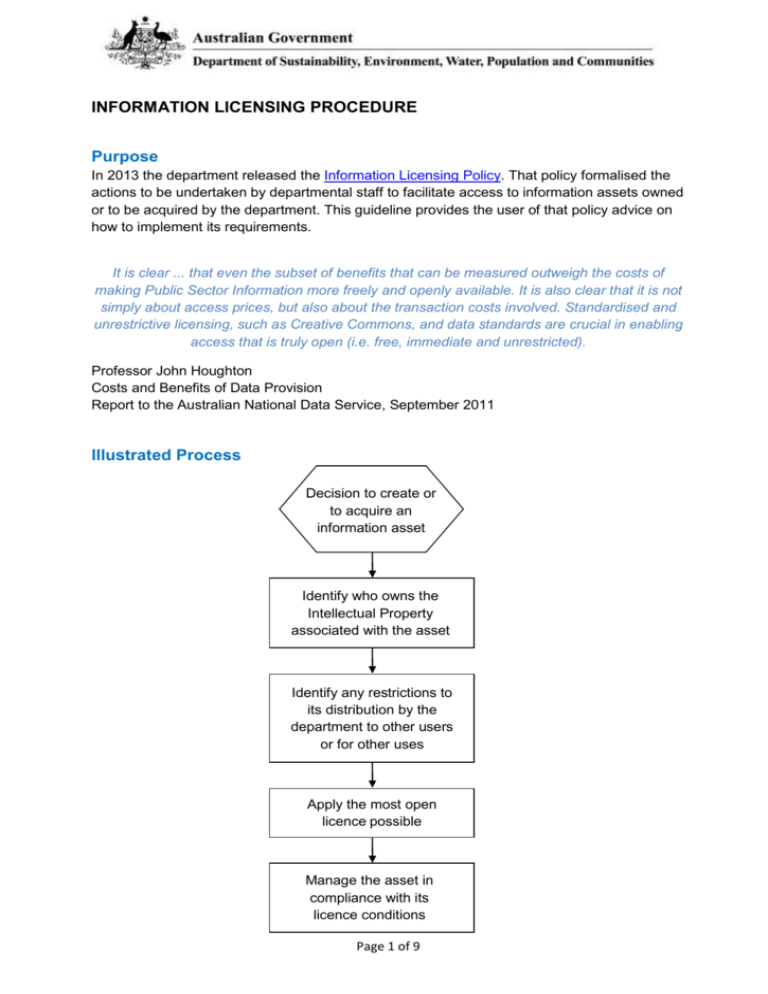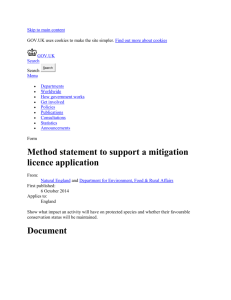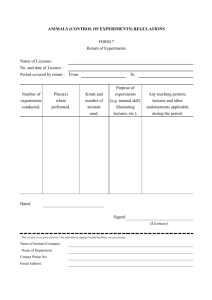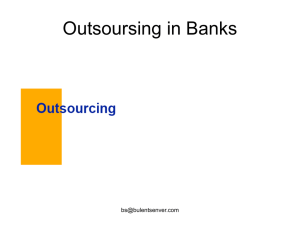Information Licensing Procedure
advertisement

INFORMATION LICENSING PROCEDURE Purpose In 2013 the department released the Information Licensing Policy. That policy formalised the actions to be undertaken by departmental staff to facilitate access to information assets owned or to be acquired by the department. This guideline provides the user of that policy advice on how to implement its requirements. It is clear ... that even the subset of benefits that can be measured outweigh the costs of making Public Sector Information more freely and openly available. It is also clear that it is not simply about access prices, but also about the transaction costs involved. Standardised and unrestrictive licensing, such as Creative Commons, and data standards are crucial in enabling access that is truly open (i.e. free, immediate and unrestricted). Professor John Houghton Costs and Benefits of Data Provision Report to the Australian National Data Service, September 2011 Illustrated Process Decision to create or to acquire an information asset Identify who owns the Intellectual Property associated with the asset Identify any restrictions to its distribution by the department to other users or for other uses Apply the most open licence possible Manage the asset in compliance with its licence conditions Page 1 of 9 Implementation Policy requirement 1: Ascertain ownership of Intellectual Property Background Intellectual property, copyright and licensing are all legal tools that assist in the management of information (including data). Licensing is a way for the creator of an idea to control how others use their data. Ownership of intellectual property plays an important role in determining the licence conditions of an information asset. Where the Commonwealth owns the intellectual property contained in an information asset, the asset can be given an open licence for access and reuse within the department and externally. Where an external party owns some or all of the intellectual property contained in an information asset that party may place restrictions on its distribution and use, which the department must comply with in its use of that information. In most cases the Commonwealth owns the intellectual property contained in information assets produced by its employees, or individuals under its direction or control.1 Exceptions to this rule are where the information asset incorporates a pre-existing information asset which has been modified by the department. In this instance the intellectual property obtained from the pre-existing assets may be owned by an external party or parties. In some circumstances it may be difficult to determine whether an information asset created by the department is sufficiently different from the original to enable the Commonwealth to assert intellectual property ownership. An example of this is where a map has been created using points from a dataset belonging to a third party. The rule of thumb is if data or information provided by an external party could be extrapolated or approximated from the newly created information asset then the Commonwealth cannot assert intellectual property ownership. Where an information asset has been created by an external party the intellectual property and copyright will normally be retained by them. However, the Commonwealth would usually gain ownership for the intellectual property of a commissioned or acquired information asset. In some circumstances the Commonwealth would gain the right to use that property through the contract or licence agreement under which it was acquired. Summary Staff must ascertain whether the Commonwealth owns the Intellectual Property contained within that information asset. The Commonwealth owns the intellectual property where: the asset was created within the department, and does not reuse pre-existing information assets which are owned by external parties; or the contract or licence agreement to obtain the information asset specifies that the information asset will belong to the Commonwealth. Attorney-General’s Department, “Licensing and use of Commonwealth material” http://www.ag.gov.au/RightsAndProtections/IntellectualProperty/Pages/LicensinganduseofCommonweal thmaterial.aspx 1 Page 2 of 9 When commissioning a new information asset through a procurement exercise staff should assert the Commonwealth’s right to ownership of that asset if possible. Procedure i. Upon commissioning the creation of a new information asset, ensure that standard funding and services agreement clauses requiring that the asset will become the property of the Commonwealth are enforced. OR ii. Upon acquiring an asset, ascertain whether the intellectual property in the asset belongs to the Commonwealth, in whole or in part. Policy requirement 2: Identify any restrictions on distribution Background Where the department does not own all of the intellectual property contained in an information asset, it must abide by the existing licence conditions (if a licence exists). These conditions may restrict distribution of the asset, both within the department and externally. They may also restrict the use of the information asset to particular purposes. External parties engaged to create information assets may not be willing or able to have open licence applied to the assets they produce. Where an information asset consists of modified or combined pre-existing information assets which belong to an external party, the restrictions on the pre-existing asset will also apply to the newly created asset. Assessing the original data source includes identifying third party works, personal or confidential information where permission for use or restrictions of release may apply. Restrictions on distribution may apply to information with a security classification or dissemination limiting marker. Restrictions from a security or sensitivity assessment can be temporary, e.g. until the Minister makes an announcement. In these cases this classification must be changed when the restrictions no longer apply, and the information licensed. Summary Where an information asset’s intellectual property is not wholly owned by the Commonwealth, staff must determine whether there are any terms and conditions that apply to the purpose and use for the information asset and whether there are any restrictions on distribution of the information asset. Importantly, staff must determine whether the licence that applies to the information asset enables the Commonwealth to sublicence the information asset. Staff must also determine whether there are any restrictions on distribution due to security classification or a dissemination limiting marker. Page 3 of 9 Procedure i. Determine whether there are any restrictions on distribution of the information asset, as determined by intellectual property rights and security classification. ii. Where an asset contains information obtained under differing licence conditions, legal advice should be sought regarding the ownership of the intellectual property and the appropriate licence for the combined asset. Policy requirement 3: Apply most open licence possible Background Licensing is a method for the owner of an asset to allow others to use it under conditions that the owner decides. Staff should preferably seek the most open licence conditions possible to enable as many people in the department (or other potential users) to benefit from that asset. In recent years the Australian Government has been moving towards a more open use of information irrespective of whether the information asset has been obtained from external parties or developed by government agencies. When information is acquired the Government is also encouraging its identification and distribution to other agencies for their use. Whole of Government licensing is the preferred approach, rather than licensing for limited use. The Attorney-General's Department advises that "Australian Government agencies are required to release copyright public sector information under Creative Commons by licence or other open content licences, wherever possible." 2 The Australian Governments Open Access and Licensing (AusGOAL) framework is considered best practice by the Australian Government for licensing information to other users. This is an accessible and detailed tool that can be applied to any information. Based on the Creative Commons licensing system, the AusGOAL framework includes six individual Creative Commons licences, one restrictive licence, and one software licence. As the Creative Commons concept has long been established it will be familiar to almost all information suppliers. The Australian Creative Commons Attribution (CC BY) licence is the department’s default information licence. As it is the most open of all Creative Commons licences it enables the maximum dissemination and use of licensed materials. Creative Commons By Attribution lets others distribute, remix, modify, and build upon other’s work (including commercially) as long as they credit the creator for the original work.3 2 Licensing and use of Commonwealth material http://www.ag.gov.au/RightsAndProtections/IntellectualProperty/Pages/LicensinganduseofCommonweal thmaterial.aspx 3 AusGOAL http://www.ausgoal.gov.au/creative-commons Page 4 of 9 Circumstances where more restrictive licences (both Creative Commons and other types) may be used include: pre-existing licence conditions on the information; unwillingness of the information provider to agree to an open licence; a security classification or a dissemination limiting marker; and privacy concerns. An alternate licence which is not Creative Commons may only be used where there are strong, non-negotiable restrictions on the use and/or distribution of the information, and there is no suitable Creative Commons licence available. The details of a licence should be recorded with that licence in an accessible place so other staff members can access those details. Information assets may be held by the department for a number of years. Recording the licence details helps to ensure compliance with existing licence conditions and also creates the greatest opportunity for reuse of the asset by other parts of the department. Summary Staff must apply the most open licence possible whilst incorporating any restrictions on distribution resulting from pre-existing licence conditions or from a security classification or a dissemination limiting marker (as identified in Policy Requirement 2). When creating a new information asset for which the department wholly owns the IP staff must apply the Creative Commons Attribution licence unless the asset has a security classification or a dissemination limiting marker. When developing a licence for an information asset which incorporates a pre-existing asset owned by an external party, the new licence must maintain the relevant licence conditions that apply to the source information. Creative Commons licence markings must be applied and displayed prominently with the material being licensed. The following details should be displayed with the CC licence symbol: the URL for the Creative Commons licence being used; the copyright symbol; the organisation name; the year of creation; and any additional information that is appropriate to the circumstances. The licence conditions for each Creative Commons licence are set out on a webpage for that licence. Providing the URL with the licence will allow users to view the licence conditions without those conditions being specifically recorded with the licence. Figure 1: Creative Commons Attribution licence symbol Page 5 of 9 Staff may wish to publish a product that includes copyright material from third parties, and to provide the broadest possible licence to the public in relation to the use of that product. In this case, identify any third party material and state that the product is provided under a Creative Commons Attribution 3.0 Australia, with the exception of content supplied by third parties, which is clearly identified. Where a non-Creative Commons licence has been used the licence conditions must be clearly specified with the licence. The asset’s metadata is the most appropriate option to record licence conditions. Restrictive licences should be reviewed annually to assess whether a less restrictive licence can be applied. Procedure i. When licensing an information asset, create the most open licence conditions possible, whilst incorporating any restrictions on distribution from pre-existing licence conditions or security requirements. AND ii. Apply the Creative Commons logo together with the licence URL, copyright symbol, organisation name, year of creation, and as much additional information as is appropriate to the circumstances. Where a non-Creative Commons licence has been used clearly specify the licence conditions in the asset’s metadata. iii. Review restrictive licences annually and apply a less restrictive licence where possible. Policy requirement 4: Manage information asset in accordance with its licence Background The department manages a large and diverse store of information assets that are owned by other entities. Most of these assets have been made available to the department with restrictions on distribution and/or use. Summary Once recorded, the licence conditions must be observed while the department has possession of that information asset, and in any use of the asset by the department. Procedure i. Comply with the licence conditions on any information asset held by the department. Page 6 of 9 Definitions Information Data, recorded ideas, knowledge and understanding. It is often described as related concepts in a hierarchy, with each concept being based on analysis and integration of the former with increasing relevance to a particular context. In this policy 'information' is used as the collective term for the whole hierarchy. Information Acquisition The obtaining of an Information Asset, which may or may not include the transfer of ownership. For example, obtaining a licence to the Information Asset does not include transfer of ownership. Note: Acquisition does not include the incidental accessing of information from the Internet. Information Asset Datasets or information products that enable departmental business functions and outcomes. Intellectual Property Covers the wide range of intangible property that is the result of the creative and intellectual effort of individuals and organisations. This includes inventions, literary and artistic works, computer programs, databases, broadcasts, films, sound recordings, plant varieties, trademarks and designs.4 It can be protected under law by copyright, patent or licensing provisions. Copyright The legal protection provided for people who express ideas and information in certain forms. The most common are writing, visual images, music and moving images.5 It is free and applies automatically when material is created. The copyright notice consists of the symbol ©, followed by the name of the copyright owner and the year of first publication. Copyright does not protect ideas, information, styles, techniques, names, titles or slogans.6 Public Sector Information Information that has been produced by, or is owned, controlled and held by, the public sector (i.e. the government). 7 Licensing Allows the creator to maintain ownership of their intellectual property, but allows a licensee to use the work as specified in their licence conditions. For example, copy and distribute the work provided they give credit to the creator of the work. Open Licensing Conditions Those that facilitate ease of access to another entity or persons’ information with minimal restrictions on its use. While complete freedom to use information in any way is the most open licensing condition, most information owners place some restrictions on use. Attorney-General’s Department, “Intellectual Property and Copyright” http://www.ag.gov.au/RightsAndProtections/IntellectualProperty/Pages/default.aspx 5 Attorney-General’s Department, “Copyright Information” http://www.ag.gov.au/RightsAndProtections/IntellectualProperty/Pages/Copyright-information.aspx 6 Australian Copyright Council, 2012, An Introduction to Copyright in Australia. 7 Access to and use of Public Sector Information, www.aupsi.org 4 Page 7 of 9 Definitions These restrictions enable the owner to keep some control, but allow others to use and benefit from it. The Australian Governments Open Access and Licensing (AusGOAL) framework is considered best practice by the Australian Government for licensing information to other users. Information Management The means by which the department plans, identifies, creates, receives, collects, organises, governs, secures, uses, controls, disseminates, exchanges, maintains, preserves and disposes of its information. The primary aim of information management is to ensure that the right information is available to the right people, in the right format, at the right time. Information Repository An IT system, library or paper filing system location where information assets are deposited, stored and made accessible to potential users. Department Information All reports, documents, data sets and other information that the department acquires or produces for statutory purposes or business needs. Information may occur in a number of formats, such as electronic (digital), print, audio, video, image, graphical, cartographic, physical sample, textual or numerical form.8 Metadata A description that serves to provide context or additional information about other information. Commonly applied metadata includes an overview of the information, a title, a description of the creator, and a date of creation. These requirements can be applied to all types of information. However, different information types will have descriptive requirements in addition to the basics. These are described in metadata standards unique to information types. 8 Queensland Government Enterprise Architecture Glossary Page 8 of 9 PROCEDURE NAME Information Licensing Procedure VERSION 1.1 PREPARED BY Environment Information Policy and Reporting Section; Sustainability Policy and Analysis Division APPROVED BY Jason Ferris DATE APPROVED 18 June 2013 LAST AMENDED 20 August 2013 DATE OF NEXT REVIEW June 2014 LICENCE With the exception of the Commonwealth Coat of Arms and where otherwise noted, SEWPaC information policies are licensed under Creative Commons Attribution 3.0 Australia licence. This procedure should be attributed to “Australian Government Department of Sustainability, Environment, Water, Population and Communities, 2013, Information Licensing Procedure”. Use of the Coat of Arms The terms under which the Coat of Arms can be used are detailed on the It’s an Honour website. http://www.itsanhonour.gov.au/coat-arms/index.cfm Page 9 of 9




